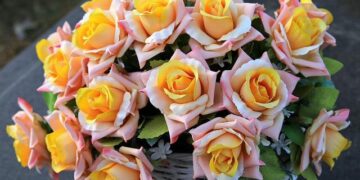AlUla’s oasis has inspired artists for millennia: Recently, Desert X AlUla has brought a fresh artistic resurgence to this striking desert landscape.
In the searing heat of the desert, a sculptured pool of stainless-steel shimmers as it reflects the bright sunlight, the image constantly changing with the time of day and angle at which it is viewed. It stands as an artistic representation of a mirage—or at least it stood. Because this work of art, like a mirage and the shifting sands of the desert, is transient, and now that the art exhibition has closed, it leaves behind no trace. It was one of the monumental installations of Desert X AlUla, a temporary art exhibition staged on a spectacular scale in the striking sandstone landscape of Saudi Arabia’s AlUla oasis.
Desert X has its roots in the Coachella Valley of California where, since 2017, exhibitions have brought the desert to life through artistic installations modeled on and within the landscape. The works by acclaimed international artists aim to amplify the beauty of the desert while expressing profound ecological, cultural, and spiritual themes shared by indigenous peoples and the wider global community. For Desert X, art is a medium for cultural exchange, and this was reflected in the choice of AlUla as its first location for a Desert X exhibition beyond the U.S.
For millennia, AlUla has been a vibrant center of cultural exchange due to its unique position as an oasis in the vast Arabian desert. The life-sustaining waters of AlUla ensured that it become a vital stop for ancient traders carrying spices, aromatics, and more across the grueling desert from southern Arabia to the Mediterranean. Later, with the spread of Islam, thousands of pilgrims from across the world passed through AlUla’s oasis each year as they traveled the pilgrimage routes to the holy cities of Makkah (Mecca) and Medina. Such international exposure made AlUla a meeting point of cultures, influencing the area’s long and artistic traditions.
Some of AlUla’s earliest art is carved into the desert landscape itself. Thousands of years ago, Neolithic, Bronze, and Iron Age artists scrambled up rock-strewn slopes to etch images into the sandstone with primitive tools. These early artworks often drew inspiration from nature, depicting animals that the artists saw, hunted, or even feared—from lions and ibex to ostriches and Arabian leopards. Spirituality also emerges in carvings of abstract human figures carrying what are interpreted to be ritual offerings, while AlUla’s prehistoric tombs show artistic qualities with their distinctive stone walls forming “tails” and other elegant shapes in the landscape.
Around 500 B.C., AlUla may even have had its own sculpture school, with the people of Dadan crafting exquisite art that may have reflected wealth, or may have been used in religious practices. Among the most impressive works are the life-size and even larger statues found at the temple of Dhu Ghabat: All look alike―men with strong limbs, defined stomachs, and broad shoulders, standing with hands clenched, left foot forward, and stern gazes. Stylistically these figures closely resemble statues found in ancient Egypt and Greece, but with Arabian additions such as headbands and bracelets—the artistic exchange given a local twist.
AlUla’s monumental art took on its most sublime form in the colossal tomb facades of Hegra, and here, too, we see far-flung cultural influences engraved into the desert. The highly skilled masons who carved these enormous and intricate facades into the desert cliffs drew inspiration from across the ancient world: a tomb might include Greco-Roman columns supporting a triangular pediment and stepped crenellations from Mesopotamia, while guarding the entrance might be sphinxes, eagles, and griffins―all powerful symbols from Egypt and Persia. And yet, Hegra’s artists didn’t adopt any single style, but instead blended all these influences into their own unique style.
And art wasn’t only for AlUla’s wealthy patrons: Many houses in AlUla Old Town were colorfully decorated with pictures painted onto their lime-washed walls. Natural pigments, from red iron oxide to a synthetic blue indigo, were used to create images of local plants and animals, household objects, as well as geometric patterns and abstract symbols, including some inspired by Islamic art. This artistic tradition continued through the centuries with more recent paintings showing cars and buses as artists again drew inspiration from the world around them.
And then there’s the desert itself: the majestic sweeping landscapes of rolling sand dunes and rugged sandstone cliffs, the vast sense of openness and quiet in which rusty colors contrast with bright-blue skies and eruptions of lush, green vegetation. With its varied and constantly changing pallet and ever-shifting shapes, AlUla’s desert has captivated and inspired for millennia.
Onto this landscape, international artists came together to establish Desert X AlUla, first in 2020 and again in 2022, in different canyon locations. Featuring the theme Sarab, meaning “mirage,” the most recent exhibition explored ideas of mirage and oasis that are so intrinsic to desert culture. The 15 newly commissioned artworks included ideas reflecting upon dreams, camouflage, fiction, appearance and disappearance, extraction, illusion, and myth. Wandering through the canyons, where they experienced art interacting with nature on a monumental scale, visitors explored a series of spectacular works.
Down the rock face of one canyon poured a meticulously crafted tapestry woven of yellow jugs known in Ghana as Kufuor gallons, these distinctive plastic containers are commonly repurposed there and used for storing water. For artist Serge Attukwei Clottey, his “Gold Falls” addressed the experience of globalization, migration, and water equity. Claudia Comte’s “Dark Suns, Bright Waves” mimicked the movement of desert dunes with a striking progression of black-and-white walls depicting a section of algorithmic pattern based on geological and natural shapes. A concave geometric structure against a timeless sandstone backdrop, Dana Awartani’s “Where the Dwellers Lay” pays homage to Nabataean tombs while reflecting the contours of AlUla’s mountains, gorges, caverns, and rock formations.
A few of these works remain in situ, others have moved to new locations, and some, like a desert mirage, are gone. But looking to the future, the ambition is to build upon these successes to create an unprecedented experience of permanent art in direct dialogue with the landscape. Within a larger context, Wadi AlFann, which means “Valley of the Arts,” plans to bring together artists from around the world to create era-defining works set within the monumental landscape of AlUla. The canvas is prepared and awaits the artists’ touches to bring it to life: Like AlUla’s rock carvings, statues, and tomb facades, this awe-inspiring art will stand the test of time—the art of the desert.
Journey through time to discover the rich history of AlUla here.
>>> Read full article>>>
Copyright for syndicated content belongs to the linked Source : National Geographic – https://www.nationalgeographic.com/travel/article/paid-content-desert-x-alula















